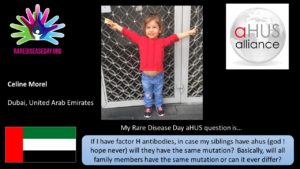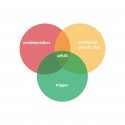Article No. 321
20 February 2020
Recalling a couple of questions in the 2017 Rare Diseases Day video about something that aHUS folk often talk about whenever they meet up. Why do some in a family have aHUS and others do not?
 Familial HUS began to be recognised when it appeared that in some families HUS was not a sporadic incident; but more than one family member had HUS . The incidents did not happen at the same time, which could be explained by HUS from e. coli poisoning, but separated by years.
Familial HUS began to be recognised when it appeared that in some families HUS was not a sporadic incident; but more than one family member had HUS . The incidents did not happen at the same time, which could be explained by HUS from e. coli poisoning, but separated by years.
It was suspected that genetic causes, that were passed down through generations ,were at play in familial HUS, or aHUS as it became known.
It has become clear that it is predisposing genetic variants/mutation, which have been found within components of the Complement System, that have made some people susceptible to aHUS. Even though for some people specific genetic variants/mutations have not been found yet. As aHUS is very rare , such specific variants/mutations will be even rarer.
Also it is not fully understood known why in families, which are known to carry a predisposing genetic variant/mutation , some in the family onset with aHUS and others do not. In fact of all aHUS patients , research has found only 1 in 5 of them are from a family where there has even been a history of aHUS. ( click here for data in Table 2)
The extent to which aHUS penetrates a family varies between each predisposing genetic variant. For some it can even be 100% ; whether across single generations ,or , even down through previous generations; but mostly it is incomplete.
Historically, aHUS probably would not be a recorded cause of death in countries even where records are kept. But, where there are such records and a family history is known, it is possible to track back over a century or more to establish the symptoms of kidney failure which may feature in certificated reasons for death. In modern times HUS or renal failure would be clear indicators ,or even odemia , a symptom of kidney failure leading to lung failure. Even very old fashioned terms like “ dropsy of the chest” may be indicative of kidney failure.
Such a search can show that aHUS can skip several generations over a century or more before it appears again.
 The reason for that can be explained by a study of penetrance of aHUS in three families in Devon with a complement factor H variant . Twenty years ago this variant was the first ever genetic cause of aHUS to be identified in 1997.( click here for more information) .
The reason for that can be explained by a study of penetrance of aHUS in three families in Devon with a complement factor H variant . Twenty years ago this variant was the first ever genetic cause of aHUS to be identified in 1997.( click here for more information) .
The Devon families were studied again nearly 20 years later; this time the penetrance of the disease in the family was looked at. There was also an attemp to find out if there were additional genetic factors which might explain incomplete penetrance.
The families were approached, and, where individuals agreed to participate, each family undertook genetic tests. The scope of the tests went beyond what those with aHUS even today would have routinely experienced in their diagnosis.
The results of those tests were reported for those surviving family members who had on set- there were nine ;and those predisposed but who had not on set – there were eighteen.
In most respects genetically all the family members were very much the same, but, in two common genetic areas, there were noticeable differences.
The genetics of the study are complicated , but in the research paper , which published the results ( click here) it was reported that two small bits of Complement Factor H looked different between each group.
In one bit all but one of those who had not onset had a similar version of it; but in those who had onset, most did not. In the other bit of CFH none of those who had onset had the version which most of those who had not onset possessed.
The researchers concluded that those who had onset with aHUS mutated bits of Complement Facor H which put them at more risk of , or less protected from , having aHUS.

The featured image above visually expresses what this means; that even if people have identical aHUS predisposing mutations ( red circle) ; and face the same triggering events ( green circle ), other small differences ( orange circle) may determine the actual outcome and who is more likely to land in the sector at the centre of the overlapping circles and onset with aHUS.
Because these “other genetic factors” are much more common in the general population ( doctors call them “polymorphisms”or “haplotypes ” ) it means that a non aHUS carrying parent can reverse the less risky / protective bits of Complement in the unaffected aHUS predisposed parent to make their offspring more at risk / less protected
Their offspring may:
- Not inherit the aHUS predisposing variant/mutation – they will not get aHUS;
- Inherit the predisposing variant/mutation, but also the protective/ less risk polymorphism- they will be very unlikely to have aHUS, but might;
- Inherit the predisposing variant/mutation and also the unprotective/greater risk “polymorphism” from the other parent.- they will be at much more risk of having aHUS and will probably be likely to do so, if a trigger is strong enough.
The study of the Devon Family can only be of clinical significance to an aHUS family with that specific genetic variant ( called C3643C>G; p.Arg 1215 Gly in doctors’ speak), but the principles behind the study are just as applicable for other susceptibility significant variants/mutations .
aHUS can skip generations; and the small difference in brothers and sisters and other blood relatives can mean they have a different experience of aHUS.
Will it be possible for aHUS families to have such detailed genetic profiling and personal counselling based on it is another question for genetic study?

